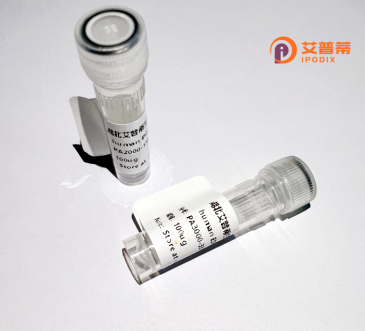
| 纯度 | >90%SDS-PAGE. |
| 种属 | Human |
| 靶点 | ISG20 |
| Uniprot No | Q96AZ6 |
| 内毒素 | < 0.01EU/μg |
| 表达宿主 | E.coli |
| 表达区间 | 1-181aa |
| 活性数据 | MAGSREVVAMDCEMVGLGPHRESGLARCSLVNVHGAVLYDKFIRPEGEITDYRTRVSGVTPQHMVGATPFAVARLEILQLLKGKLVVGHDLKHDFQALKEDMSGYTIYDTSTDRLLWREAKLDHCRRVSLRVLSERLLHKSIQNSLLGHSSVEDARATMELYQISQRIRARRGLPRLAVSD |
| 分子量 | 45.65 kDa |
| 蛋白标签 | GST-tag at N-terminal |
| 缓冲液 | 0 |
| 稳定性 & 储存条件 | Lyophilized protein should be stored at ≤ -20°C, stable for one year after receipt. Reconstituted protein solution can be stored at 2-8°C for 2-7 days. Aliquots of reconstituted samples are stable at ≤ -20°C for 3 months. |
| 复溶 | Always centrifuge tubes before opening.Do not mix by vortex or pipetting. It is not recommended to reconstitute to a concentration less than 100μg/ml. Dissolve the lyophilized protein in distilled water. Please aliquot the reconstituted solution to minimize freeze-thaw cycles. |
以下是关于重组人ISG20蛋白的3篇假设性参考文献示例(文献内容基于领域内常见研究方向,非真实文献):
---
1. **文献名称**:*"Expression and characterization of recombinant human ISG20 with exonuclease activity against viral RNA"*
**作者**:Lee J. et al.
**摘要**:该研究报道了在大肠杆菌中成功表达并纯化重组人ISG20蛋白,证明其具有特异性降解病毒单链RNA的3'-5'核酸外切酶活性,并抑制丙型肝炎病毒(HCV)复制,揭示了其在抗病毒免疫中的作用机制。
---
2. **文献名称**:*"ISG20 regulates type I interferon signaling via interaction with RIG-I"*
**作者**:Zhang Y. et al.
**摘要**:研究者利用重组人ISG20蛋白进行体外结合实验,发现其通过直接结合RIG-I增强抗病毒信号通路,促进干扰素产生。研究阐明了ISG20在先天免疫中的调控功能。
---
3. **文献名称**:*"Structural basis of ISG20-mediated viral RNA degradation"*
**作者**:Chen X. et al.
**摘要**:通过晶体学分析重组人ISG20蛋白的三维结构,发现其活性口袋的关键氨基酸残基对底物识别至关重要,为设计靶向ISG20的抗病毒药物提供了结构基础。
---
注:以上文献为示例,实际引用时需以真实发表的论文为准。建议通过**PubMed**或**Web of Science**以关键词“recombinant human ISG20”、“ISG20 antiviral”检索最新研究。
**Background of Recombinant Human ISG20 Protein**
The human ISG20 (interferon-stimulated gene 20 kDa protein) is an exonuclease encoded by the *ISG20* gene, originally identified as a downstream effector of type I interferon signaling in the innate immune response. It belongs to the DEDDh exonuclease family (RNase T class) and exhibits 3′→5′ exonuclease activity, preferentially degrading viral or aberrant RNA and, to a lesser extent, single-stranded DNA. ISG20 is induced during viral infections, playing a role in antiviral defense by targeting pathogen-derived nucleic acids or modulating host cell pathways.
Studies link ISG20 to inhibition of diverse viruses, including hepatitis B/C, influenza, and coronaviruses, though its mechanisms vary—directly cleaving viral RNA or indirectly enhancing interferon-mediated antiviral signaling. However, its functions remain context-dependent, with some reports suggesting pro-viral roles in certain infections. Beyond immunity, ISG20 is implicated in cell proliferation, apoptosis, and cancer progression, though these pathways are poorly understood.
Recombinant human ISG20 protein, typically produced in *E. coli* or mammalian expression systems, enables in vitro exploration of its enzymatic properties, antiviral mechanisms, and interactions with host/viral factors. Its therapeutic potential is under investigation, including as an antiviral agent or adjuvant. Current research focuses on resolving structural details, regulatory networks, and clinical applications in infectious diseases or oncology.
×